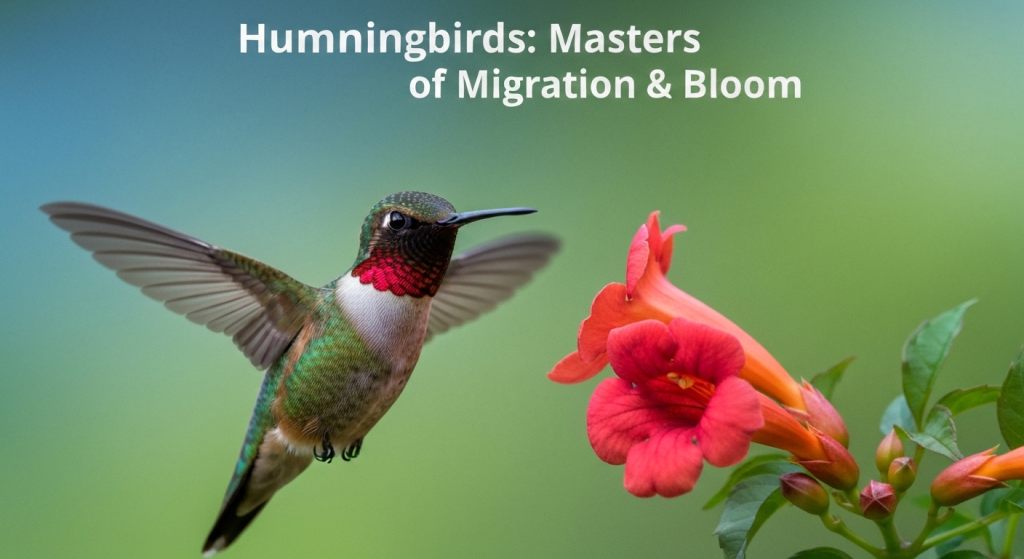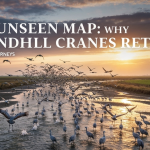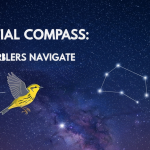Have you ever stood in your garden and marveled at the arrival of the first hummingbird of the season? One day the yard is quiet, and the next, a tiny, iridescent jewel appears, hovering at the very flowers that just opened. It’s a magical moment, one that feels like a secret whispered between the bird and the blossom. This isn’t just a happy coincidence. It’s one of nature’s most intricate and beautifully synchronized ballets, a journey timed with incredible precision. The survival of these tiny athletes depends entirely on arriving just as their floral refueling stations open for business.
My name is Mahnoor Farooq, and for years, I’ve been exploring and writing about the fascinating world of bird species. My passion lies in untangling the complex relationships between birds and their environments, turning scientific research into clear, understandable stories. The more I’ve observed hummingbirds, the more I’ve been captivated by their migration. It’s a journey of immense endurance that relies on a deep, evolutionary connection to the plant world. Understanding this timing isn’t just for bird enthusiasts; it’s a window into the delicate health of our ecosystems.
The High-Stakes Journey: Why Timing is Everything
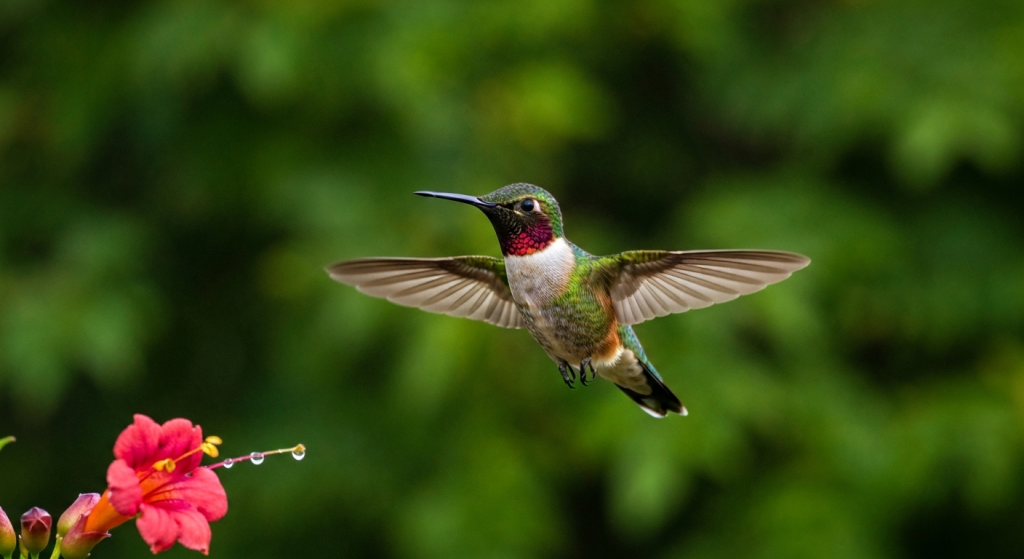
To understand why the timing of hummingbird migration is so critical, we first need to appreciate the sheer physical challenge of the journey itself. These birds are not casual travelers; they are elite endurance athletes pushing the limits of what seems possible for a creature that weighs less than a nickel.
A Fuel-Intensive Flight
A hummingbird’s life is lived at an incredible pace. Its heart can beat over 1,200 times per minute, and its wings can flap 50 to 80 times per second. This high metabolism requires a constant, massive intake of calories just to survive a normal day. Now, let’s consider migration. During their journey, which can span thousands of miles, their energy expenditure goes into overdrive.
From my five years of tracking migration data and observing these birds, the most stunning fact remains their pre-migration preparation. A hummingbird can nearly double its body weight in the weeks before it migrates, storing fat as fuel. This fat is the only thing that will sustain it for hundreds of miles of non-stop flight. If a hummingbird runs out of fuel mid-journey, there is no second chance. This is why arriving at a destination where flowers are not yet blooming is a life-or-death situation.
Nectar as High-Octane Fuel
So, what is the perfect fuel for such a demanding flight? The answer is nectar. Flower nectar is nature’s equivalent of a high-performance energy drink. It’s primarily composed of simple sugars—sucrose, glucose, and fructose—which are easy for the hummingbird’s body to convert directly into energy. It also provides essential water, which is crucial for hydration during long flights.
Let’s break it down. The bird needs a reliable, widespread, and easily digestible energy source all along its migration route. Nectar-producing flowers provide exactly that. The relationship is a perfect example of mutual benefit: the bird gets the fuel it needs to survive, and in return, it pollinates the flowers, ensuring their reproduction.
| Activity Level | Primary Energy Use | Typical Caloric Need (per day) |
| Resting / Perched | Basic metabolic functions, maintaining body temperature. | Low |
| Daily Foraging | Short flights, hovering, territorial defense. | Moderate |
| Migratory Flight | Sustained, long-distance flight, fat metabolism. | Extremely High (up to 10x normal) |
Nature’s Calendar: The Cues Hummingbirds Use to Migrate
Hummingbirds don’t just guess when it’s time to go. They rely on a sophisticated set of internal and external signals that have been fine-tuned over millions of years of evolution. These cues ensure they leave at the right time and follow a path that will lead them to food.
Reading the Sun: The Role of Photoperiod
The most reliable and consistent environmental cue for migration is the photoperiod, or the changing length of daylight. Unlike temperature or weather, which can be erratic from year to year, the change in day length is perfectly predictable. As the days grow shorter in late summer, it triggers hormonal changes in the hummingbird’s body. This is the fundamental signal that says, “It’s time to prepare for the journey south.”
Similarly, as the days grow longer in their wintering grounds in Central America or Mexico, it signals that it’s time to begin the trek north. This solar calendar is the master trigger that sets the entire migration process in motion. It’s what tells them to start fattening up and feeling the instinctual pull to move.
The Internal Clock: Hormonal and Genetic Programming
Beyond the external cue of daylight, hummingbirds have an internal, genetic roadmap. This innate programming dictates not only the urge to migrate but also the general direction they should travel. Scientists believe this is a powerful instinct passed down through generations. Young hummingbirds making their first migration journey do so alone, without parental guidance. They are relying entirely on this inherited knowledge to navigate a route they have never seen before. This internal compass, combined with the photoperiod trigger, creates a robust system for initiating migration.
Following the “Green Wave”: Phenological Matching
This is where the magic really happens. Once the journey is underway, hummingbirds time their northward spring migration to match the blooming of flowers. This concept is known as phenological matching. In simple terms, they follow the spring season as it advances across the continent. This wave of blooming flowers, or “green wave,” provides a continuous chain of refueling stations.
As I’ve observed in my own work, this isn’t just about finding any flower. Hummingbirds often rely on a succession of specific native plant species. For example, as Ruby-throated Hummingbirds move up the eastern United States, their journey might first coincide with the blooming of Red Buckeye trees, then later with Trumpet Honeysuckle, and finally with Jewelweed in the north. They are essentially leap-frogging from one blooming habitat to the next, a behavior that requires their travel speed to perfectly match the pace of spring.
A Two-Way Street: How Flowers and Hummingbirds Evolved Together
The tight synchronization between hummingbirds and flowers is no accident. It is the product of millions of years of coevolution, where two species mutually influence each other’s evolutionary path. The hummingbird’s need for nectar and the flower’s need for pollination created a perfect partnership.
Designed for a Purpose: Flower Adaptations
Flowers that rely on hummingbirds for pollination have evolved a specific set of traits to attract them. This syndrome of traits is known as ornithophily, or “bird-loving.” A common question I get from gardeners is how to attract hummingbirds, and the answer almost always lies in planting flowers that exhibit these features.
- Color: Hummingbirds see well in the red and orange parts of the spectrum. As a result, many hummingbird-pollinated flowers are vibrant shades of red, orange, or pink, making them stand out against a green background.
- Shape: These flowers are often long and tubular, perfectly matching the shape of a hummingbird’s long, slender bill. This shape also prevents most insects from accessing the nectar, saving it for the intended pollinator.
- Nectar Content: The nectar in these flowers is typically high in sucrose and copious in volume, providing a rich energy reward that makes the visit worthwhile for the bird.
- Lack of Scent: Birds generally have a poor sense of smell, so hummingbird-pollinated flowers rarely have a strong fragrance. They advertise with color, not scent.
This coevolutionary dance means that the birds have come to recognize these flowers as reliable fuel sources, and the flowers have become increasingly dependent on the birds for their reproductive success.
When the Clock is Wrong: The Growing Threat of Climate Change
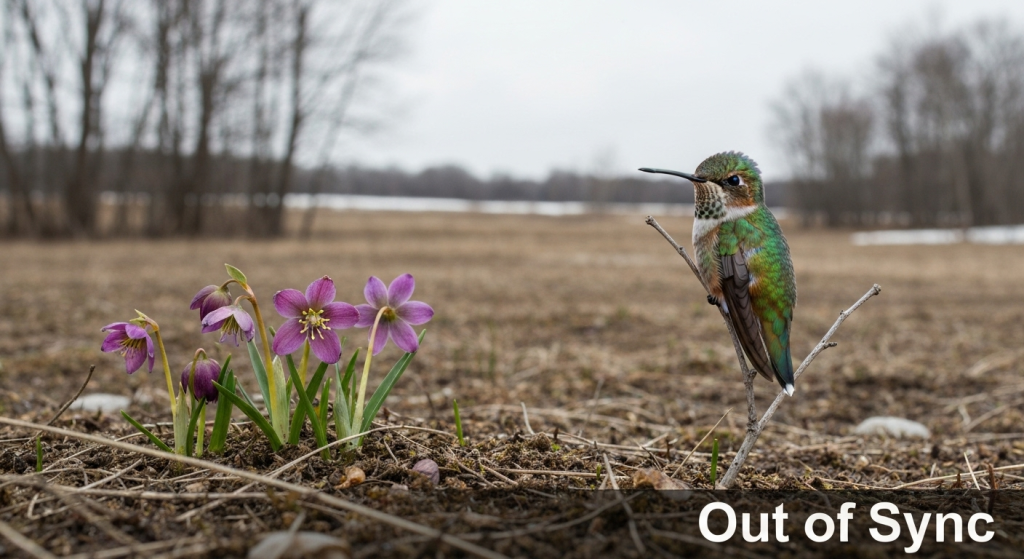
For millennia, this finely tuned system has worked flawlessly. However, our rapidly changing climate is introducing a new and dangerous variable: phenological mismatch. This is a growing concern among ornithologists and ecologists who study migratory birds.
The Problem of a Timing Mismatch
Here’s the core of the problem: plants and birds are responding to different climate change cues. Many plants initiate their blooming based on temperature. As global temperatures rise, springs are arriving earlier, and flowers are blooming sooner than they did just a few decades ago.
However, the primary cue for hummingbirds to begin migration—day length—is not changing at all. It remains constant. The result is a dangerous gap. The hummingbirds, following their ancient solar calendar, may begin their migration at the traditional time, only to arrive on their breeding grounds to find that their key nectar sources have already bloomed and faded. This mismatch between the bird’s arrival and its food source can be catastrophic.
Real-World Consequences
When a hummingbird arrives at its destination exhausted and with its fat reserves depleted, it desperately needs to refuel. If the flowers aren’t ready, or have already passed their peak, the bird may struggle to survive. This can lead to several devastating outcomes:
- Increased Starvation: Birds may starve before they can find an alternative food source.
- Reduced Breeding Success: Even if they survive, females may be too weak to lay a full clutch of eggs, or they may not have enough energy to successfully raise their young.
- Population Decline: Over time, these individual struggles can lead to a measurable decline in the overall population of a species.
| Factor | Traditional Timing (Synchronized) | Mismatch Scenario (Climate Change) |
| Primary Plant Cue | Temperature/Day Length (aligned) | Warmer Temperature |
| Primary Bird Cue | Day Length (constant) | Day Length (constant) |
| Flower Bloom Time | Aligns with bird arrival. | Occurs 1-2 weeks before bird arrival. |
| Hummingbird Arrival | Bird arrives to peak bloom. | Bird arrives after peak bloom. |
| Outcome | Successful refueling and breeding. | Risk of starvation, poor breeding success. |
The Journey Varies: Species-Specific Migration Strategies
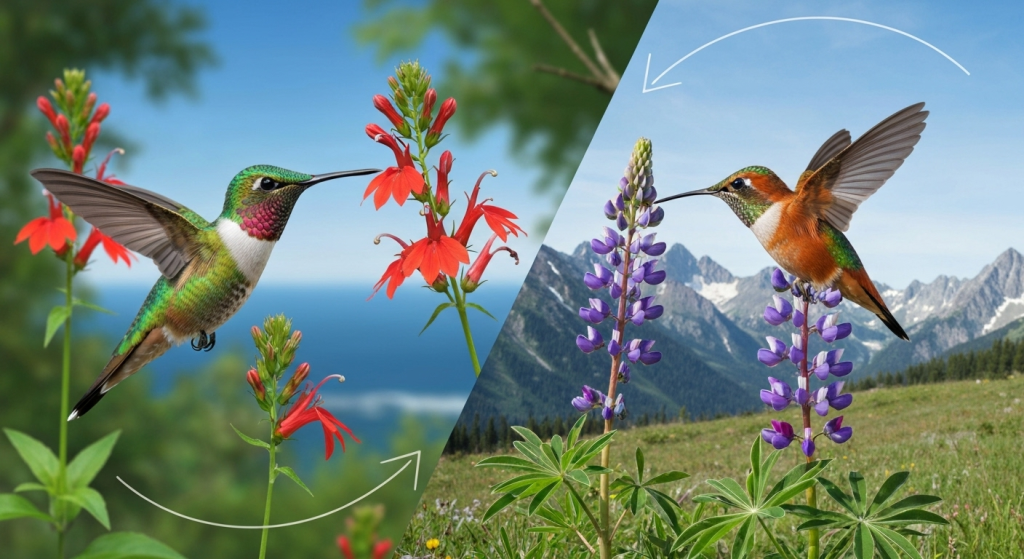
Not all hummingbirds follow the same playbook. Different species have developed unique migration routes and strategies tailored to the landscapes they traverse and the flowers they depend on.
The Marathoner: The Ruby-throated Hummingbird
The Ruby-throated Hummingbird is the only species that breeds in the eastern United States. Many of them undertake a breathtaking non-stop flight of over 500 miles across the Gulf of Mexico. To do this, they must be perfectly fueled and time their departure with favorable weather. Their northward route is a steady advance, following the blooming of trees and wildflowers up the coast and into the northern forests.
The Mountain Hopper: The Rufous Hummingbird
The Rufous Hummingbird has a fascinating loop migration. In the spring, it travels north along the Pacific Coast, a route rich with early-blooming flowers like salmonberry and red-flowering currant. After breeding in the northwest, it takes a completely different route south, traveling through the high-altitude meadows of the Rocky Mountains. This path allows it to take advantage of the late-summer wildflower blooms at high elevations, a brilliant strategy for finding fuel on the return journey.
The Resident Specialist: Anna’s Hummingbird
Once restricted to California, the Anna’s Hummingbird has dramatically expanded its range northward in recent decades. This is partly due to milder winters but also because of human activity. The widespread planting of exotic, winter-blooming garden plants and the prevalence of hummingbird feeders have created a year-round food supply that has allowed this species to become a permanent resident in places like Oregon and Washington. This shows how adaptable some species can be when resources are available.
Frequently Asked Questions (FAQs)
What is the main trigger for hummingbirds to start migrating?
The primary and most reliable trigger is the photoperiod, or the changing length of daylight. This signals hormonal changes that prepare the bird for its long journey.
Do all hummingbird species migrate?
No. While many species are migratory, some, like the Anna’s Hummingbird in parts of its range, are year-round residents. Their ability to stay depends on a consistent, year-round food source.
How can I help migrating hummingbirds in my yard?
The best way is to plant native, nectar-rich flowers that bloom at different times throughout the season. You can also put out a hummingbird feeder with a simple solution of 1 part white sugar to 4 parts water. It is critical to keep the feeder clean to prevent harmful mold.
What happens if hummingbirds arrive and their main flower food isn’t blooming?
This is a dangerous situation known as a phenological mismatch. The birds arrive with low energy reserves and may struggle to find enough food to survive and breed successfully, potentially leading to starvation or failed nesting attempts.
Conclusion
The synchronized arrival of a hummingbird with the blooming of a flower is one of the most beautiful and delicate events in the natural world. It is a testament to an evolutionary partnership millions of years in the making, guided by the sun, an internal compass, and a deep connection to the land. This intricate dance, however, is fragile. As our climate continues to change, the risk of this timing falling out of sync grows greater every year. By understanding the profound connection between these tiny migrants and their floral fuel sources, we can better appreciate the importance of protecting their habitats and taking action to preserve the balance of our ecosystems. Every native flower we plant is a helping hand, a refueling station for a tiny traveler on an epic journey.
